
Very few governments might have been confronted with the high expectations that faces the current Lepep administration. Backed by electoral promises to usher in a “second economic miracle” under the primeministership of Sir Anerood Jugnauth, expectations were set high. As a result, there is increased scrutiny regarding their performance in addressing economic woes.
Setting aside the political implications, there is a dire need to redress the economy. Mauritius has performed below its potential when it comes to economic growth. According to estimates by the International Monetary Fund, our country's optimum growth rate is at around 6%. However, in 2015, the country did not perform better than 3.4% that is, less than 60% of its capacity.
Numerous factors explain that, the global economy is still struggling to recover; China and emerging markets' lesser than expected growth figures; and Europe still recovering from the unemployment and sovereign debt crises. On the local front, tourism had an excellent year with arrivals crossing the one million mark. However, same cannot be said of other sectors. Construction experienced its fourth straight year of contraction, down 4.3% in 2015. Figures for previous years are: 2012 (-3%) 2013 (-9.4%) and 2014 (-8.5%).
At industry level, the main growth figures for 2015 as per Statistics Mauritius are:
- Sugarcane: negative growth of -8.2% based on a production of 370,000 tonnes of sugar.
- Manufacturing: growth of 1.5% mainly explained by lower performance of sugar milling (-7.6%) and textile manufacturing (-1%).
- Construction: decline of -4.3% (explained by delays in the implementation of both major public and private projects).
- Tourism industry: growth of 8.6%, (based tourist arrivals of 1,140,000).
- Sugarcane: Growth of 4.8% based on production of 390,000 tons of sugar.
- Manufacturing: Growth of 2.5%, based on expected diversification of markets and an increase in the production of SMEs.
- Electricity, gas, steam and air conditioning supply: Growth of 4.5% based on the expected increase in demand by local enterprises which are expected to increase production in 2016.
- Construction: Growth of 2% based on pick up of construction activities.
- Transport and storage: Growth of 3.4%, based on higher activities in the port.
- Accommodation and food service: Growth of 4.5% based on expected tourist arrivals of 1.2 million and tourism earnings of Rs 52 billion.
- Financial and insurance: Growth of 5.3% in line with the government strategy to attract world class liquidity providers, international broker firms, investment banks, insurance companies and fund managers.
- Professional, scientific and technical activities: Growth of 6.5% based on expected pick up in services allied to the construction sector.
- Public administration and Defence; compulsory social security: Growth 3.5% considering expected increase in the level of employment in the public sector.

Notre service WhatsApp. Vous êtes témoins d`un événement d`actualité ou d`une scène insolite? Envoyez-nous vos photos ou vidéos sur le 5 259 82 00 !































